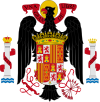
Back إسبانيا الفرانكوية Arabic سپانيا لفرانكاوية ARY Франкісцкая Іспанія Byelorussian Франкісцкая Гішпанія BE-X-OLD Франкистка Испания Bulgarian Frankistické Španělsko Czech Spanien under Franco Danish Franco-Diktatur German Δικτατορία του Φρανθίσκο Φράνκο Greek Frankisma Hispanio Esperanto
This article needs additional citations for verification. (August 2020) |
Spanish State Estado Español (Spanish) | |||||||||||
|---|---|---|---|---|---|---|---|---|---|---|---|
| 1936–1975 | |||||||||||
Flag of Spain
(1945–1977) Coat of arms
(1945–1977) | |||||||||||
| Motto: Una, Grande y Libre ("One, Great and Free") Plus Ultra ("Further Beyond") | |||||||||||
| Anthem: Marcha Granadera ("Grenadier March") | |||||||||||
 Territories and colonies of the Spanish State:
| |||||||||||
| Capital and largest city | Madrid[a] | ||||||||||
| Official languages | Spanish | ||||||||||
| Religion | Catholicism (official); under the doctrine of National Catholicism | ||||||||||
| Demonym(s) | Spanish, Spaniard | ||||||||||
| Government | Unitary Francoist one-party personalist dictatorship | ||||||||||
| Head of States | |||||||||||
• 1936–1975 | Francisco Franco | ||||||||||
• 1975 | Alejandro Rodriguez de Valcarcel | ||||||||||
| Prime Minister | |||||||||||
• 1938–1973 | Francisco Franco | ||||||||||
• 1973 | Luis Carrero Blanco | ||||||||||
• 1973 | Torcuato Fernández-Miranda (acting) | ||||||||||
• 1973–1975 | Carlos Arias Navarro | ||||||||||
| Prince | |||||||||||
• 1969–1975 | Juan Carlos I | ||||||||||
| Legislature | Cortes Españolas | ||||||||||
| Historical era | Interwar period • World War II • Cold War | ||||||||||
| 17 July 1936 | |||||||||||
| 1 April 1939 | |||||||||||
| 6 July 1947 | |||||||||||
• UN membership | 14 December 1955 | ||||||||||
| 1 January 1967 | |||||||||||
• Francisco Franco's death | 20 November | ||||||||||
| 22 November 1975 | |||||||||||
| Area | |||||||||||
| 1940[1] | 856,045 km2 (330,521 sq mi) | ||||||||||
| Population | |||||||||||
• 1940[1] | 25,877,971 | ||||||||||
| Currency | Spanish peseta | ||||||||||
| Calling code | +34 | ||||||||||
| |||||||||||
| Today part of | |||||||||||
Francoist Spain (Spanish: España franquista), also known as the Francoist dictatorship (dictadura franquista), was the period of Spanish history between 1936 and 1975, when Francisco Franco ruled Spain after the Spanish Civil War with the title Caudillo. Two days after his death in 1975 due to heart failure, Spain transitioned into a democracy. During Franco's rule, Spain was officially known as the Spanish State (Estado Español).
The nature of the regime evolved and changed during its existence. Months after the start of the Civil War in July 1936, Franco emerged as the dominant rebel military leader and was proclaimed head of state on 1 October 1936, ruling a dictatorship over the territory controlled by the Nationalist faction. The 1937 Unification Decree, which merged all parties supporting the rebel side, led to Nationalist Spain becoming a single-party regime under the FET y de las JONS. The end of the Civil War in 1939 brought the extension of the Franco rule to the whole country and the exile of Republican institutions. The Francoist dictatorship originally took a form described as "fascistized dictatorship",[2] or "semi-fascist regime",[3] showing clear influence of fascism in fields such as labor relations, the autarkic economic policy, aesthetics, and the single-party system.[4][5] As time went on, the regime opened up and became closer to developmental dictatorships, although it always preserved residual fascist trappings.[6][3]
During the Second World War, Spain did not join the Axis powers (its supporters from the Civil War, Italy and Germany). Nevertheless, Spain supported them in various ways throughout most of the war while maintaining its neutrality as an official policy of non-belligerence. Because of this, Spain was isolated by many other countries for nearly a decade after World War II, while its autarkic economy, still trying to recover from the Civil War, suffered from chronic depression. The 1947 Law of Succession made Spain a de jure kingdom again but defined Franco as the head of state for life with the power to choose the person to become King of Spain and his successor.
Reforms were implemented in the 1950s and Spain abandoned autarky, reassigned authority from the Falangist movement, which had been prone to isolationism, to a new breed of economists, the technocrats of Opus Dei.[7] This led to massive economic growth, second only to Japan, that lasted until the mid-1970s, known as the "Spanish miracle". During the 1950s, the regime also changed from a rigidly totalitarian and repressive system to a slightly milder authoritarian system with limited pluralism and economic freedom.[8] As a result of these reforms, Spain was allowed to join the United Nations in 1955 and Franco was one of Europe's foremost anti-communist figures during the Cold War, and his regime was assisted by the Western powers, particularly the United States. Franco died in 1975 at the age of 82. He restored the Spanish monarchy before his death and made his successor King Juan Carlos I, who would lead the Spanish transition to democracy.
- ^ (in Spanish) "Resumen general de la población de España en 31 de Diciembre de 1940". INE. Retrieved 11 October 2014.
- ^ Saz 2004, p. 90.
- ^ a b «La tesis defendida por Payne en dicho dossier puede sintetizarse con estas palabras:
» Glicerio Sanchez Recio. En torno a la Dictadura franquista Hispania NovaEntre 1937 y 1943, el franquismo constituyó un régimen "semi-fascista", pero nunca un régimen fascista cien por cien. Después pasó treinta y dos años evolucionando como un sistema autoritario "posfascista", aunque no consiguió eliminar completamente todos los vestigios residuales del fascismo.
- ^ Moradiellos 2000, p. 20.
- ^ Cabrera & Rey 2017; Capítulo V
- ^ «La ausencia de un ideario definido le permitió transitar de unas fórmulas dictatoriales a otras, rozando el fascismo en los cuarenta y a las dictaduras desarrollistas en los sesenta».Tusell 1999, cap. «El franquismo como dictadura».
- ^ Reuter, Tim (19 May 2014). "Before China's Transformation, There Was The 'Spanish Miracle'". Forbes Magazine. Retrieved 22 August 2017.
- ^ Payne (2000), p. 645

